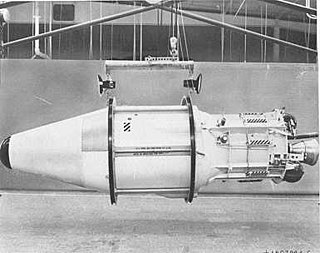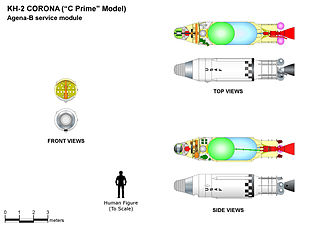
The Corona program was a series of American strategic reconnaissance satellites produced and operated by the Central Intelligence Agency Directorate of Science & Technology with substantial assistance from the U.S. Air Force. The Corona satellites were used for photographic surveillance of the Soviet Union (USSR), the People's Republic of China, and other areas beginning in June 1959 and ending in May 1972.

Gemini 12 was a 1966 crewed spaceflight in NASA's Project Gemini. It was the 10th and final crewed Gemini flight, the 18th crewed American spaceflight, and the 26th spaceflight of all time, including X-15 flights over 100 kilometers (54 nmi). Commanded by Gemini VII veteran James A. Lovell, the flight featured three periods of extravehicular activity (EVA) by rookie Edwin "Buzz" Aldrin, lasting a total of 5 hours and 30 minutes. It also achieved the fifth rendezvous and fourth docking with an Agena target vehicle.

KH-5 ARGON was a series of reconnaissance satellites produced by the United States from February 1961 to August 1964. The KH-5 operated similarly to the Corona series of satellites, as it ejected a canister of photographic film. At least 12 missions were attempted, but at least 7 resulted in failure. The satellite was manufactured by Lockheed. Launches used Thor-Agena rockets flying from Vandenberg Air Force Base, with the payload being integrated into the Agena.

BYEMAN codenamed LANYARD, the KH-6 was the unsuccessful first attempt to develop and deploy a very high-resolution optical reconnaissance satellite by the United States National Reconnaissance Office. Launches and launch attempts spanned the period from March to July 1963. The project was quickly put together to get imagery of a site near Leningrad suspected of having anti-ballistic missiles. The satellite carried Itek's "E-5" camera developed for the SAMOS program, which had been cancelled. The camera had a focal length of 1.67 m (66 in) and could discern objects on the ground 1.8 m (6 ft) in size. The ground swath of the camera was 14 x 74 km. The satellite weighed 1,500 kg, and had a single re-entry vehicle in which exposed film was returned to earth for a mid-air aircraft recovery. The KH-6 was manufactured by Lockheed Martin and launched from Vandenberg Air Force Base on Thor-Agena D rockets.

The SAMOS or SAMOS-E program was a relatively short-lived series of reconnaissance satellites for the United States in the early 1960s, also used as a cover for the initial development of the KH-7 GAMBIT system. Reconnaissance was performed with film cameras and television surveillance from polar low Earth orbits with film canister returns and transmittals over the United States. SAMOS was first launched in 1960 from Vandenberg Air Force Base.

Thor was a US space launch vehicle derived from the PGM-17 Thor intermediate-range ballistic missile. The Thor rocket was the first member of the Delta rocket family of space launch vehicles. The last launch of a direct derivative of the Thor missile occurred in 2018 as the first stage of the final Delta II.

Discoverer 1 was the first of a series of satellites which were part of the CORONA reconnaissance satellite program. It was launched on a Thor-Agena A rocket on 28 January 1959 at 21:49:16 GMT from Vandenberg Air Force Base in California. It was a prototype of the KH-1 satellite, but did not contain either a camera or a film capsule. It was the first satellite launched toward the South Pole in an attempt to achieve polar orbit, but was unsuccessful. A CIA report, later declassified, concluded that "Today, most people believe the DISCOVERER 1 landed somewhere near the South Pole."

Discoverer 14 was a spy satellite used in the Corona program managed by Advanced Research Projects Agency (ARPA) of the Department of Defense and the United States Air Force. On 19 August 1960, usable photographic film images of the Soviet Union taken by the satellite were recovered by a C-119 recovery aircraft. This was the first successful recovery of film from an orbiting satellite and the first mid-air recovery of an object returning from Earth orbit.
SECOR was a series of small United States Armed Forces satellites launched in the 1960s for geodesy measurements that precisely determined the locations of points on the Earth's surface, particularly of isolated islands in the Pacific. This data allowed for improved global mapping and precise positioning of ground stations for other satellites.
OPS 3762, also known as FTV-2355, was an American reconnaissance satellite which was launched in 1964. It was the first radar imaging satellite to be launched, and the only Quill spacecraft to fly. Its mission was to demonstrate radar imaging techniques for future missions. However, the programme was cancelled before any more satellites were launched.
FTV-2203, also known as Samos 5, was an American reconnaissance satellite launched in 1961 as part of the Samos programme. It was a film return reconnaissance spacecraft, meaning that it returned images in a film capsule at the end of its mission. FTV-2203 was a Samos-E5 spacecraft, based on the Agena-B. It carried a camera with a focal length of 1.67 metres and a resolution of 1.5 metres.
Discoverer 23, also known as KH-5 9016A, was a USAF photographic reconnaissance satellite under the supervision of the National Reconnaissance Office (NRO) which was launched in 1961. It was a KH-5 ARGON satellite, based on an Agena-B. It was the second KH-5 mission to be launched, and the second to end in failure.
Discoverer 24, also known as Corona 9018A, was an American area survey optical reconnaissance satellite which was launched in 1961 but failed to achieve orbit. It was a KH-5 Argon satellite, based on an Agena-B. It was the third KH-5 to be launched.
Discoverer 27, also known as Corona 9020A, was an American area survey optical reconnaissance satellite launched in 1961, but which failed to achieve orbit. It was a KH-5 Argon satellite, based on an Agena-B. It was the fourth KH-5 to be launched, the second consecutive KH-5 launch failure, and the fourth consecutive KH-5 mission failure.
FTV-1132, also known as the Corona 9042A, was an American area survey optical reconnaissance satellite which was launched in 1962. It was a KH-5 Argon satellite, based on an Agena-B. The satellite operated successfully, but its film capsule was lost during recovery due to a parachute failure.

Discoverer 17, also known as Corona 9012, was an American optical reconnaissance satellite launched on 12 November 1960 at 20:38:00 GMT. It was the second of ten Corona KH-2 satellites, based on the Agena-B.

Discoverer 18, also known as Corona 9013, was an American optical reconnaissance satellite launched on 7 December 1960 at 20:24:00 GMT. It was the first successful, and the third of ten total Corona KH-2 satellites, based on the Agena-B.

Discoverer 9 was an American military reconnaissance satellite, launched on 4 February 1960 as a part of the DISCOVERER program, at 18:51:00 GMT, from Vandenberg Air Force Base on the Thor-Agena launch vehicle. The Thor cut off 20 seconds early and left the Agena without sufficient velocity or attitude control. It began tumbling and the engine shut down after only 20 seconds of operation, sending the payload into the Pacific Ocean. At liftoff, an improper disconnect of a pad umbilical also caused a loss of helium pressurization gas in the Agena's propellant tanks.
Discoverer 10 was an American military reconnaissance satellite as a part of the DISCOVERER program. The satellite was launched on 19 February 1960, at 20:15 GMT, from Vandenberg Air Force Base on the Thor-Agena launch vehicle. The booster began exhibiting abnormal pitch oscillations almost immediately at liftoff and Range Safety Officer sent the destruct command at T+56 seconds when allowable safety margins were exceeded. Most of the debris fell in and around launch complex LC 75-3-4. The failure was traced to a malfunction of Thor's guidance computer due to a suspected unauthorized repair modification.










